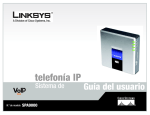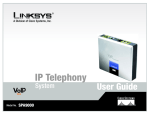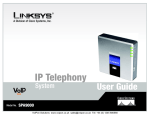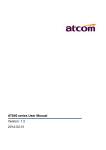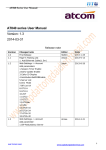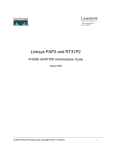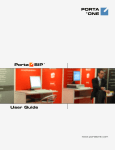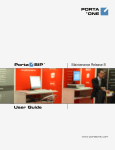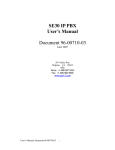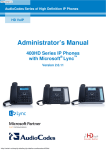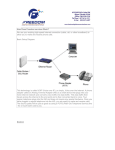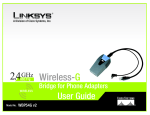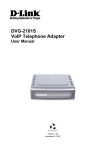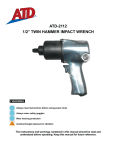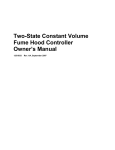Download Sipura Technology SPA-2000 User's Manual
Transcript
Sipura Technology, Inc. SPA-2000 User Guide December 2003 Sipura SPA-2000 User Guide v1.0.3.doc © 2003 Sipura Technology, Inc Proprietary (See Copyright Notice on Page 2) 1 Disclaimer – Please Read: This document contains implementation examples and techniques using Sipura Technology, Inc. and, in some instances, other company’s technology and products and is a recommendation only and does not constitute any legal arrangement between Sipura Technology, Inc. and the reader, either written or implied. The conclusions reached and recommendations and statements made are based on generic network, service and application requirements and should be regarded as a guide to assist you in forming your own opinions and decision regarding your particular situation. As well, Sipura Technology reserves the right to change the features and functionalities for products described in this document at any time. These changes may involve changes to the described solutions over time. Use of Proprietary Information and Copyright Notice: This document contains proprietary information that is to be used only by Sipura Technology customers. Any unauthorized disclosure, copying, distribution, or use of this information is prohibited. © 2003 Sipura Technology, Inc Proprietary (See Copyright Notice on Page 2) 2 Sipura Technology, Inc. SPA-2000 User Guide Table of Contents 1. 2. 3. 4. 5. 6. Product Description .................................................................................................................................................... 4 1.1. SPA-2000 Hardware Overview ........................................................................................................................ 4 1.1.1. Status LED Description:.............................................................................................................................. 5 Installation Overview .................................................................................................................................................. 6 Software Configuration............................................................................................................................................... 6 3.2. IVR Interface.................................................................................................................................................... 7 3.2.1. IVR Conventions: ....................................................................................................................................... 7 3.2.2. SPA-2000 Interactive Voice Response (IVR) Menu: ................................................................................... 8 3.3. SPA Web Interface ........................................................................................................................................ 10 3.3.1. Web Interface Conventions ...................................................................................................................... 10 3.3.2. Administration Privileges .......................................................................................................................... 10 3.3.3. Basic and Advanced Views ...................................................................................................................... 11 3.3.4. SPA-2000 Web Page Configuration Default Values.................................................................................. 12 3.4. Configuration Parameters .............................................................................................................................. 19 3.4.1. System Parameters .................................................................................................................................. 19 System Configuration .................................................................................................................................................... 19 Network Configuration ................................................................................................................................................... 19 3.4.2. Provisioning Parameters........................................................................................................................... 19 3.4.3. Upgrade Parameters ................................................................................................................................ 20 3.4.4. Protocol Parameters................................................................................................................................. 20 3.4.5. Line 1 and Line 2 Parameters................................................................................................................... 23 3.4.6. User 1 and User 2 Parameters ................................................................................................................. 26 3.4.7. Regional Parameters................................................................................................................................ 28 3.5. Call Statistics Reporting................................................................................................................................. 32 User Guidelines........................................................................................................................................................ 33 4.1. Basic Services ............................................................................................................................................... 34 4.1.1. Originating a Phone Call........................................................................................................................... 34 4.1.2. Receiving a Phone Call ............................................................................................................................ 34 4.2. Enhanced Services........................................................................................................................................ 34 4.2.1. Caller ID ................................................................................................................................................... 34 4.2.2. Calling Line Identification Presentation (CLIP).......................................................................................... 35 4.2.3. Calling Line Identification Restriction (CLIR) – Caller ID Blocking ............................................................. 35 4.2.4. Call Waiting .............................................................................................................................................. 36 4.2.5. Disable or Cancel Call Waiting ................................................................................................................. 37 4.2.6. Call-Waiting with Caller ID ........................................................................................................................ 38 4.2.7. Voice Mail................................................................................................................................................. 38 4.2.8. Attendant Call Transfer............................................................................................................................. 39 4.2.9. Unattended or “Blind” Call Transfer .......................................................................................................... 39 4.2.10. Call Hold ............................................................................................................................................. 40 4.2.11. Three-Way Calling .............................................................................................................................. 40 4.2.12. Three-Way Ad-Hoc Conference Calling............................................................................................... 41 4.2.13. Call Return .......................................................................................................................................... 41 4.2.14. Automatic Call Back ............................................................................................................................ 42 4.2.15. Call FWD – Unconditional ................................................................................................................... 42 4.2.16. Call FWD – Busy................................................................................................................................. 43 4.2.17. Call FWD - No Answer ........................................................................................................................ 44 4.2.18. Anonymous Call Blocking.................................................................................................................... 45 4.2.19. Distinctive / Priority Ringing and Call Waiting Tone ............................................................................. 45 4.2.20. Speed Calling – Up to Eight (8) Numbers or IP Addresses .................................................................. 46 Where to Get Support: ............................................................................................................................................. 48 Appendix I – Dial Plan Administration:...................................................................................................................... 49 6.1.1. Dial Plan................................................................................................................................................... 49 © 2003 Sipura Technology, Inc Proprietary (See Copyright Notice on Page 2) 3 1. Product Description This guide describes basic administration and use of the Sipura Technology SPA-2000 phone adapter – an intelligent low-density Voice over IP (VoIP) gateway. The SPA-2000 enables carrier class residential and business IP Telephony services delivered over broadband or high-speed Internet connections. By intelligent we mean the SPA-2000 maintains the states of all the calls it terminates. It is capable of making proper decisions in reaction to user input events (such as on/off hook or hook flash or enhanced services codes, i.e. *69) with little or no involvement by a middle-man server or media gateway controller. 1.1. SPA-2000 Hardware Overview The SPA-2000 has one of the smallest form factors on the market. It can be installed in minutes as a table-top or wall mount CPE device. Figures Figure 1, Figure 2, Figure 3 and Figure 5 show the front, rear, left side and right side of the SPA-2000, respectively. Figure 1 – SPA-2000 Front Figure 2 – SPA-2000 Rear Figure 3 – SPA-2000 Left Side Figure 4 – SPA-2000 Right Side The SPA-2000 has the following interfaces for networking, power and visual status indication: 1. Two (2) RJ-11 Type Analog Telephone Jack Interfaces (Figure 4, above): These interfaces accept standard RJ-11 telephone connectors. An Analog touchtone telephone or fax machine may be connected to either interface. If the service supports only one incoming line, the analog telephone or fax machine should be connected to port one (1) of the SPA-2000. Port one (1) is the outermost telephone port on the SPA-2000 and is labeled “Phone 1.” 2. One LED for Unit Status (Figure 4, above): © 2003 Sipura Technology, Inc Proprietary (See Copyright Notice on Page 2) 4 This LED indicates status via the following behaviors: ON – LED remains solid on OFF – LED remains solid off LONG (Long On) – 3.0s on, 1s off continuously FAST – 0.125s on, 0.125s off continuously SLOW – 0.5s on, 0.5s off continuously VSLO (Very Slow) – 1.0s on, 1.0s off continuously HB (Heart Beat) – 0.125s on, 0.125s off, 0.125s on, 1s off continuously 3. One Ethernet 10baseT RJ-45 Jack Interface ( Figure , above): This interface accepts a standard or crossover Ethernet cable with standard RJ-45 connector. For optimum performance, Sipura Technology recommends that a Category 5 cable or greater be used in conjunction with the SPA-2000. 4. One LED for Data Link and Activity ( Figure , above): This LED indicates status via the following behaviors: ON – LED remains solid on OFF – LED remains solid off FAST – 0.125s on, 0.125s off continuously SLOW – 0.5s on, 0.5s off continuously Variable Blink – LED blinks according to packet traffic activity 5. One 5 Volt Power Adapter Interface ( Figure , above) This interface accepts the SPA-2000 power adapter that came with the unit. Sipura Technology does not support the use of any other power adapters other then the power adapter that was shipped with the SPA-2000 unit. 1.1.1. Status LED Description: The SPA-2000 Status LED is used to indicate the current operation status of the SPA unit. The state is represented by a special blinking pattern of the Status LED (next to the RJ-11 ports on the right side of the device). The below table describes the various modes and behaviors of the SPA-2000 in relation to the Status LED and the handset behavior. Status Description Normal Operation – Both Lines on hook Normal Operation – Either line off hook Downloading new firmware Writing firmware to flash Looking for DHCP Server No DHCP Server IP Address Conflict © 2003 Sipura Technology, Inc LED Blink Rate OFF ON SLOW FAST SLOW SLOW SLOW Default Handset Behavior Normal Normal Silent Silent Silent Silent Silent Proprietary (See Copyright Notice on Page 2) 5 Unknown DHCP Error SLOW Silent Note: The Link LED will blink on transmit and receive (TX/RX) of packets. The LED will display solid off if no link is available. The LED will display solid on if link is up but no TX/RX activity is present. Important Warning: Do not disrupt the power to the SPA-2000 while the Status LED is blinking FAST. 2. Installation Overview Please check to make sure that you have the following package contents: 1. Sipura Phone Adapter Unit 2. Ethernet Cable 3. SPA-2000 QuickGuide 4. 5 Volt Power Adapter You will also need: 1. One or Two Analog Touch Tone Telephones (or Fax Machine) 2. Access to an IP Network via an Ethernet Connection Please observe the following steps to install the SPA-2000. From the Left Side of the SPA-2000: 1. Insert a standard RJ-45 Ethernet cable (included) into the LAN port. 2. Insert the power adapter cable into the 5V power adapter cable receptacle. Ensure that the power adapter jack is snugly attached to the SPA. From the Right Side of the SPA-2000: 1. Insert a standard RJ-11 telephone cable into the Phone 1 port. 2. Connect the other end of the cable to an analog telephone or fax machine. 3. Insert a standard RJ-11 telephone cable into the Phone 2 port (Optional). 4. Connect the other end of the cable to an analog telephone or fax machine. Note: Do not connect RJ-11 telephone cable from the SPA to the wall jack to prevent any chance of connection to the circuit switched telco network. You may now insert the plug end of the power adapter into a live power outlet which will power up the SPA-2000. 3. Software Configuration 3.1.1.1. Firmware Upgrade The SPA-2000 is firmware upgradeable via TFTP or via an executable PC program obtained from Sipura Technology or an authorized distributor/reseller of Sipura Technology products. Please contact the company from whom you purchased your SPA-2000 for access to Sipura Technology firmware upgrades. Firmware Upgrade via TFTP: Firmware designed for TFTP upgrades are released as single binary files, which contain all the modules pertaining to any one release version. By convention, the firmware loads are named with the extension “.bin” (e.g. spa.bin) The SPA-2000 can be configured to upgrade to a specific version, possibly staging through intermediate releases, if necessary. This process can be automated for a pool of devices through configuration profile parameters. © 2003 Sipura Technology, Inc Proprietary (See Copyright Notice on Page 2) 6 Alternatively, an individual SPA-2000 can be directed to perform an upgrade to a specific firmware load via its built-in web server interface. Firmware upgrades are attempted only when the SPA-2000 is idle, since they trigger a software reboot. Firmware Upgrade via PC Utility Program: From time to time, Sipura Technology will make available a PC executable file that will facilitate the upgrade of a SPA-2000. In order to upgrade a device via this method, the end user must have administrative permission (via password protected log-in) to perform this upgrade. Once the user has obtained the proper firmware upgrade executable, the user simply runs the program from a file location on their local PC. The PC program walks the user through the upgrade process via a graphical user interface. Generally, the entire upgrade process should take no more than five minutes to complete. Please note: Some end-users who have obtained their SPA-2000 directly from a service provider will never need to manually upgrade their device. Via the remote upgrade process, Sipura Technology provides capability for the SPA-2000 to be maintained from a remote location (e.g. a service provider network server), using the Internet connection of the end-user as the conduit through which profile updates and firmware upgrades are performed. 3.2. IVR Interface Administrators and/or users can check (read) and set (write) basic network configuration settings via a touchtone telephone connected to one of the RJ-11 phone ports of the SPA-2000. Please Note: Service Providers offering service using the SPA-2000 may restrict, protect or turn off certain aspects of the unit’s IVR and web configuration capabilities. The Interactive Voice Response (IVR) capabilities of the SPA are designed to give the administrator and/or user basic read/write capabilities such that the unit can attain basic IP network connectivity and, if allowed by the service provider, the more advanced browser-based configuration menu may be accessed. 3.2.1. IVR Conventions: 1. The SPA IVR uses the following conventions: By factory default, there is no password. No password authentication is required for all the IVR settings. If Administrator password is set, password authentication will be prompted for certain IVR settings. See 3.3.2 for detailed information about administrator password. Please note: The Administrator and User passwords may only be set via the SPA-2000 web interface. To input the password using the phone keypad, the following translation convention applies: o To input: A, B, C, a, b, c -- press ‘2’ o To input: D, E, F, d, e, f -- press ‘3’ o To input: G, H, I, g, h, i -- press ‘4’ o To input: J, K, L, j, k, l -- press ‘5’ o To input: M, N, O, m, n, o -- press ‘6’ o To input: P, Q, R, S, p, q, r, s -- press ‘7’ o To input: T, U, V, t, u, v -- press ‘8’ © 2003 Sipura Technology, Inc Proprietary (See Copyright Notice on Page 2) 7 o To input: W, X, Y, Z, w, x, y, z -- press ‘9’ o To input all other characters in the administrator password, press ‘0’ Note: This translation convention only applies to the password input. For example: to input password “test#@1234” by phone keypad, you need to press the following sequence of digits: 8378001234. 2. After entering a value, press the # (pound) key to indicate end of input. o To Save value, press ‘1’ o To Review the value, press ‘2’ o To Re-enter the value, press ‘3’ o To Cancel the value entry and return to the main configuration menu, press ‘*’ (star) Please Note: o The final ‘#’ key will not be counted as part of the value. o Saved settings will take effect when the telephone is hung-up and if necessary, the SPA2000 will automatically reboot. 3. After one minute of inactivity, the unit times out. The user will need to re-enter the configuration menu from the beginning by pressing * * * *. 4. If, while entering a value (like an IP address), you decide to exit without entering any changes, you may do so by pressing the * (star) key twice within a half second window of time. Otherwise, the entry of the * (star) key will be treated as a dot (decimal point). Example: To enter an IP address, use numbers 0 – 9 on the telephone key pad. Use the * (star) key to enter a decimal point. To enter the following IP address value: 192.168.2.215 A. Use the touchtone key pad to enter: 192*168*2*215# B. When prompted, enter 1 to save setting to configuration. C. Hang-up the phone to cause setting to take effect. - or D. Enter the value of the next setting category to modify . . . 5. Hang-up the phone to cause all settings to take effect. 3.2.2. SPA-2000 Interactive Voice Response (IVR) Menu: IVR Action Enter IVR Menu Check DHCP IVR Menu Choice **** 100 © 2003 Sipura Technology, Inc Parameter(s) Notes: None Ignore SIT or other tones until you hear, “Sipura configuration menu. Please enter option followed by the pound key or hang-up to exit.” None IVR will announce if DHCP in enabled or disabled. Proprietary (See Copyright Notice on Page 2) 8 Enable/Disable DHCP 101 Enter 1 to enable Enter 0 to disable Check IP Address 110 None IVR will announce the current IP address of SPA. Set Static IP Address 111 Enter IP address using numbers on the telephone key pad. Use the * (star) key when entering a decimal point. DHCP must be “Disabled” otherwise you will hear, “Invalid Option,” if you try to set this value. Check Network Mask 120 None IVR will announce the current network mask of SPA. Set Network Mask 121 Enter value using numbers on the telephone key pad. Use the * (star) key when entering a decimal point. DHCP must be “Disabled” otherwise you will hear, “Invalid Option,” if you try to set this value. Check Static Gateway IP Address 130 None IVR will announce the current gateway IP address of SPA. Set Static Gateway IP Address 131 Enter IP address using numbers on the telephone key pad. Use the * (star) key when entering a decimal point. DHCP must be “Disabled” otherwise you will hear, “Invalid Option,” if you try to set this value. Check MAC Address 140 None IVR will announce the MAC address of SPA in hex string format. Check Firmware Version 150 None IVR will announce the version of the firmware running on the SPA. Enable/Disable Web Server of SPA 7932 Enter 1 to enable Enter 0 to disable Requires Password Manual Reboot of Unit 732668 None After you hear “Option Successful,” hang-up. Unit will reboot automatically. Factory Reset of Unit 73738 Enter 1 to confirm Enter * (start) to cancel operation SPA will prompt for confirmation. After confirming, you will hear “Option Successful.” Hang- WARNING: © 2003 Sipura Technology, Inc Proprietary (See Copyright Notice on Page 2) 9 up. Unit will reboot and all configuration parameters will be reset to factory default values. ALL SETTINGS WILL BE LOST! Note: If the Administrator password is not set, the items marked with “Requires Password” will not require a password. 3.3. SPA Web Interface The SPA provides a built-in web server. Convenient configuration and administration can be performed through an integral web interface. 3.3.1. Web Interface Conventions The SPA uses the following conventions with the web administration capabilities: o The SPA-2000 web administration supports two privilege levels: Administrator and User. To use the User privilege, simply point a web browser at the IP address of the SPA-2000; to use the administrator privilege, use URL http://IP_Address_Of_SPA/admin/. See 3.3.2 for more information about administration privileges. o Version 1.0 of the SPA supports Internet Explorer 5.5 and above and Netscape 7.0 and above. o The web configuration pages can be password protected. See 3.3.2 for more information about password protect. o The user name of web Administrator is : admin o The user name of web User is : user o Note: The user names for both administrator and User are fixed and cannot be changed. o o After making changes to SPA-2000 configuration parameters, pressing “Submit All Changes” button will apply all the changes and if necessary, automatically reboot the device. Multiple changes may be made on multiple page tabs of the web interface at the same time. Pressing “Submit All Changes” will apply all the modifications. Important Note: switching between page tabs won’t apply the changes to SPA-2000, The only way to apply the changes is to press the “Submit All Changes” button. If the “Undo All Changes” button is clicked, any modifications to profile parameters on any and all pages will be reset back to their original values before modification. NOTE: Pressing the “Undo All Changes” has no effect on the SPA-2000; it will only reset the values on the web page. 3.3.2. Administration Privileges The SPA-2000 supports two levels of administration privileges: Administrator and User, both privileges can be password protected. Important note: by factory default, there are no passwords assigned for both Administrator and User. The Administrator has the privilege to modify all web profile parameters and can also modify the passwords of both Administrator and User. A User only has the privilege to access part of the web © 2003 Sipura Technology, Inc Proprietary (See Copyright Notice on Page 2) 10 profile parameters. The parameter group that the User can access is specified by the Administrator, which can only be done through provisioning the SPA-2000 via the TFTP process. To access the Administrator level privilege, use the following URL: http://IP_Address_Of_SPA/admin/. If the password has been set for Administrator, the browser will prompt for Administrator authentication. The username for Administrator is “admin” and cannot be changed. To access the User level privilege, use URL: http://IP_Address_Of_SPA/. If the password has been set for User, the browser will prompt for User authentication. The username for User is “user” and cannot be changed. When browsing Administrator pages, one can switch to User privileges by clicking the link “User Login”. (Note: if User password was set, the browser will prompt for User authentication when you click the “User Login” link). Conversely, from the User pages you can switch to Administrator privilege by clicking the link “Admin Login.” Authentication is needed if the Administrator password has been previously set. Warning: Switching between the User and Administrator will discard the uncommitted changes that have already been made on the web pages. 3.3.3. Basic and Advanced Views The web configuration interface provides a Basic and an Advanced view from which the various configuration parameters can be accessed. The SPA Provisioning tab is only visible from the Advanced Administrator view of the web interface. Warning: Switching between the basic and advanced view will discard the uncommitted changes that have already been made on the web pages. © 2003 Sipura Technology, Inc Proprietary (See Copyright Notice on Page 2) 11 3.3.4. SPA-2000 Web Page Configuration Default Values The following figures depict the default values and web page locations of the SPA-2000 web administration and configuration pages. The SPA-2000 Administrator Log-in, Advanced screen settings are shown below. Figure 1 – SPA-2000 Information Web Page (Advanced Admin View) © 2003 Sipura Technology, Inc Proprietary (See Copyright Notice on Page 2) 12 Figure 2 – SPA-2000 System Configuration Web Page (Advanced Admin View) © 2003 Sipura Technology, Inc Proprietary (See Copyright Notice on Page 2) 13 Figure 3 – SPA-2000 SIP Configuration Web Page (Advanced Admin View) © 2003 Sipura Technology, Inc Proprietary (See Copyright Notice on Page 2) 14 Figure 4 – SPA-2000 Provisioning Configuration Web Page (Advanced Admin View) © 2003 Sipura Technology, Inc Proprietary (See Copyright Notice on Page 2) 15 Figure 5 – SPA-2000 Regional Configuration Web Page (Advanced Admin View) © 2003 Sipura Technology, Inc Proprietary (See Copyright Notice on Page 2) 16 Figure 6 – SPA-2000 Line 1 Configuration Web Page (Line 2 Is Identical) © 2003 Sipura Technology, Inc Proprietary (See Copyright Notice on Page 2) 17 Figure 7 – SPA-2000 User 1 Configuration Web Page (User 2 Is Identical) © 2003 Sipura Technology, Inc Proprietary (See Copyright Notice on Page 2) 18 3.4. Configuration Parameters 3.4.1. System Parameters Parameter Name Admin Password User Password Enable Web Server System Configuration Description The password for administrator The password for User Enable/disable web server of SPA Default Yes This feature should only be used on firmware version 1.0.9 or later. Parameter Name DHCP Host Name Domain Name Static IP NetMask Gateway Primary DNS Secondary DNS DNS Query Mode Syslog Server Debug Server Debug Level Network Configuration Description Enable/Disable DHCP Host Name of SPA The network domain of SPA Static IP address of SPA, which will take effect if DHCP is disabled The NetMask used by SPA when DHCP is disabled The default gateway used by SPA when DHCP is disabled DNS server used by SPA in addition to DHCP supplied DNS servers if DHCP is enabled; when DHCP is disabled, this will be the primary DNS server. DNS server used by SPA in addition to DHCP supplied DNS servers if DHCP is enabled; when DHCP is disabled, this will be the secondary DNS server. Do parallel or sequential DNS Query Specify the syslog server name and port. This feature specifies the server for logging SPA system information and critical events. The debug server name and port. This feature specifies the server for logging SPA debug information. The level of detailed output depends on the debug level parameter setting. The higher the debug level, the more debug information will be generated. Zero (0) means no debug information will be generated. Default Yes 0.0.0.0 255.255.255. 0 0.0.0.0 0.0.0.0 0.0.0.0 Parallel 0 Notes: - Parallel DNS query mode: SPA-2000 will send the same request to all the DNS servers at the same time when doing a DNS lookup, the first incoming reply will be accepted by SPA-2000. - To log SIP messages, Debug Level must be set to at least 2. - If both Debug Server and Syslog Server are specified, syslog messages are also logged to the Debug Server. 3.4.2. Provisioning Parameters Provisioning operations are gated by the Provision_Enable parameter. Parameter Name Provision Enable Description Master enable for configuration profile resync operations © 2003 Sipura Technology, Inc Proprietary (See Copyright Notice on Page 2) Default Yes 19 Resync On Reset Resync Random Delay Resync Periodic Resync Error Retry Delay Resync From SIP Profile Rule Log Resync Request Msg Log Resync Success Msg Log Resync Failure Msg GPP A GPP B GPP C GPP D Resyncs configuration profile from configuration server whenever the SPA-2000 resets. Spread interval for resync requests Yes Resyncs configuration profile periodically after reset. Retry interval following resync failure 3600 3600 Enables resync of configuration profile from a SIP command. Configuration profile URL script. Syslog message generated when attempting a resync Yes /spa.cfg 2 Syslog message generated after a successful resync Syslog message generated after a failed resync General purpose parameter General purpose parameter General purpose parameter General purpose parameter empty empty empty empty Note: In a customized SPA-2000, the profile rule would point to a service provider’s server. 3.4.3. Upgrade Parameters Parameter Name Upgrade Enable Upgrade Error Retry Delay Upgrade Rule Log Upgrade Request Msg Log Upgrade Success Msg Log Upgrade Failure Msg Description Master enable for firmware upgrade operations Retry interval following upgrade failure Default Yes 3600 Upgrade script. Syslog message generated when attempting an upgrade empty Syslog message generated after a successful upgrade Syslog message generated after a failed upgrade Note: In a customized SPA-2000, the upgrade rule would point to a service provider’s server. 3.4.4.Protocol Parameters Parameter Name Max Forward Max Redirection Description SIP Max-Forward value. Range: 1 – 255 Number of times to allow an INVITE to be redirected by a 3xx response to avoid an infinite loop. Default 70 5 Note: This parameter currently has no effect: there is no limit on number of redirection. Max Auth SIP User Agent Name SIP Server Name Maximum number of times a request may be challenged (0-255) User-Agent Header to be used by the unit in outbound requests. If empty, the header is not included. Server Header to used by the unit in responses to inbound responses. If empty, the header is not included. © 2003 Sipura Technology, Inc Proprietary (See Copyright Notice on Page 2) 2 Sipura/ $version Sipura/ $version 20 SIP Accept Language Remove Last Reg SIP T1 SIP T2 SIP T4 SIP Timer B SIP Timer F SIP Timer H SIP Timer D SIP Timer J INVITE Expires ReINVITE Expires Reg Min Expires Reg Max Expires Reg Retry Intvl 1 SIT1 RSC 1 SIT2 RSC 1 SIT3 RSC 1 SIT4 RSC Try Backup RSC Retry Reg RSC 2 RTP Port Min 2 RTP Port Max RTP Packet Size Accept-Language Header to be used by the unit. If empty, the header is not included. Remove last registration before registering a new one if value is different one. RFC 3261 T1 value (RTT Estimate). Range: 0 – 64 sec RFC 3261 T2 value (Maximum retransmit interval for non-INVITE requests and INVITE responses). Range: 0 – 64 sec RFC 3261 T4 value (Maximum duration a message will remain in the network). Range: 0 – 64 sec INVITE time out value. Range: 0 – 64 sec Non-INVITE time out value. Range: 0 – 64 sec INVITE final response time out value. Range: 0 – 64 sec ACK hang around time. Range: 0 – 64 sec Non-INVITE response hang around time. Range: 0 – 64 sec INVITE request Expires header value in sec. 0 = do not include 31 Expires header in INVITE. Range: 0 – (2 – 1) ReINVITE request Expires header value in sec. 0 = do not 31 include Expires header in the request. Range: 0 – (2 – 1) Minimum registration expiration time allowed from the proxy in the Expires header or as a Contact header parameter. If proxy returns something less this value, then the minimum value is used. Maximum registration expiration time allowed from the proxy in the Min-Expires header. If value is larger than this, then the maximum value is used Interval to wait before the SPA retries registration again after encountering a failure condition during last registration SIP response status code to INVITE on which to play the SIT1 Tone SIP response status code to INVITE on which to play the SIT2 Tone SIP response status code to INVITE on which to play the SIT3 Tone SIP response status code to INVITE on which to play the SIT4 Tone SIP response status code on which to retry a backup server for the current request Interval to wait before the SPA retries registration again after encountering a failure condition during last registration Minimum port number for RTP transmission and reception Maximum port number for RTP transmission and reception Packet size in sec. Valid values must be multiple of 0.01s. Range: 0.01 – 0.16 no .5 4 5 32 32 32 32 32 180 30 1 7200 30 30 16384 16482 0.02 Notes: 1. Reorder or Busy Tone will be played by default for all unsuccessful response status code 2. <RTP Port Min> and <RTP Port Max> should define a range that contains at least 4 even number ports, such as 100 – 106 3.4.4.1. Dynamic Payload Types Parameter Name © 2003 Sipura Technology, Inc Description Default Proprietary (See Copyright Notice on Page 2) 21 1,2 NSE Dynamic Payload 1,2 AVT Dynamic Payload 1,2 G726r16 Dynamic Payload 1,2 G726r24 Dynamic Payload 1,2 G726r40 Dynamic Payload 1,2 G729b Dynamic Payload NSE dynamic payload type AVT dynamic payload type G726-16 dynamic payload type G726-24 dynamic payload type G726-40 dynamic payload type G729b dynamic payload type 100 101 98 97 96 99 Notes: 1. Valid range is 96 – 127 2. The configured dynamic payloads are used for outbound calls only where the SPA-2000 presents the SDP offer. For inbound calls with a SDP offer, SPA-2000 will follow the caller’s dynamic payload type assignments 3.4.4.2. SDP Audio Codec Names Parameter Name NSE Codec Name AVT Codec Name G711a Codec Name G711u Codec Name G726r16 Codec Name G726r24 Codec Name G726r32 Codec Name G726r40 Codec Name G729a Codec Name G729b Codec Name Description NSE Codec name used in SDP AVT Codec name used in SDP G711a Codec name used in SDP G711u Codec name used in SDP G726-16 Codec name used in SDP G726-24 Codec name used in SDP G726-32 Codec name used in SDP G726-40 Codec name used in SDP G729a Codec name used in SDP G729b Codec name used in SDP Default NSE telephone-event PCMA PCMU G726-16 G726-24 G726-32 G726-40 G729a G729ab Notes: 1. SPA-2000 uses the configured codec names in its outbound SDP 2. SPA-2000 ignores the codec names in incoming SDP for standard payload types (0 – 95). 3. For dynamic payload types, SPA-2000 identifies the codec by the configured codec names. Comparison is case-insensitive. 3.4.4.3. NAT Support Parameter Name Handle_VIA_received Handle_VIA_rport Insert VIA received Insert VIA rport Substitute VIA addr Send Resp To Src Port STUN Server STUN Enable Description If set to “yes”, the SPA will process the “received” parameter in the VIA header inserted by the server in a response to any one of its request. Else the parameter is ignored. If set to “yes”, the SPA will process the “rport” parameter in the VIA header inserted by the server in a response to any one of its request. Else the parameter is ignored. Insert received parameter in VIA header in SIP responses if received from IP and VIA sent-by IP differ Insert rport parameter in VIA header in SIP responses if received-from port and VIA sent-by port differ Use nat-mapped IP:port values in VIA header Send response to the request source port instead of the VIA sent-by port STUN server to contact for NAT mapping discovery Enable the use of STUN to discover NAT mapping © 2003 Sipura Technology, Inc Proprietary (See Copyright Notice on Page 2) Default No No No No No No No 22 Ext IP Ext RTP Port Min NAT Keep Alive Intvl External IP address to substitute for the actual IP address of the unit in all outgoing SIP messages. If “0.0.0.0” is specified, no IP address substitution is performed. External port mapping of <RTP Port Min>. If this value is nonzero, the RTP port number in all outgoing SIP messages is substituted by the corresponding port value in the external RTP port range. 0.0.0.0 Interval between sending NAT-mapping keep alive message in sec 15 0 Notes: 3.4.5. Line 1 and Line 2 Parameters Per line parameter tags must be appended with [1] or [2] (corresponding to lines 1 or 2) in the configuration profile. It is omitted below for readability. 3.4.5.1. User Account Information Parameter Name Description Line Enable Enable this line for service SIP Port SIP message listening port and transmission port Ext SIP Port External port to substitute for the actual SIP port of the unit in all outgoing SIP messages. If “0” is specified, no SIP port substitution is performed. SIP TOS/DiffServ TOS/DiffServ field value in UDP IP Packets Value carrying a SIP Message RTP TOS/DiffServ TOS/DiffServ field value in UDP IP Packets Value carrying a RTP data NAT Mapping Enable Enable the use of externally mapped of IP address and SIP/RTP ports in SIP messages. The mapping may be discovered by any of the supported methods. NAT Keep Alive If set to “yes”, the configured <NAT Keep Alive Enable Msg> is sent periodically every <NAT Keep Alive Intvl> seconds. NAT Keep Alive Msg Contents of the keep-alive message to be sent to a given destination periodically to maintain the current NAT-mapping. It could be an empty string. If value is $NOTIFY, a NOTIFY message is sent as keep alive. If value is $REGISTER, a REGISTER message w/o Contact is sent. NAT Keep Alive Dest Destination to send NAT keep alive messages to. If value is $PROXY, it will be sent to the current proxy or outbound proxy SIP Debug Option None, 1-line, full, exclude OPTIONS, exclude REGISTER, exclude NOTIFY, … Proxy SIP Proxy Server for all outbound requests Use Outbound Proxy Enable the use of <Outbound Proxy>. If set to “no”, <Outbound Proxy> and <Use OB Proxy in Dialog) is ignored. Outbound Proxy SIP Outbound Proxy Server where all outbound requests are sent as the first hop. © 2003 Sipura Technology, Inc Default Yes 5060 0 0x68 0xb8 No No $NOTIFY $PROXY none No No Proprietary (See Copyright Notice on Page 2) 23 Use OB Proxy In Dialog Register Make Call Without Reg Ans Call Without Reg Register Expires 1 Use DNS SRV Display Name User ID Password Auth ID Use Auth ID Whether to forcer SIP requests to be sent to the outbound proxy within a dialog. Ignored if <Use Outbound Proxy> is “no” or <Outbound Proxy> is empty Enable periodic registration with the <Proxy>. This parameter is ignored if <Proxy> is not specified. Allow making outbound calls without successful (dynamic) registration by the unit. If “No”, dial tone will not play unless registration is successful Allow answering inbound calls without successful (dynamic) registration by the unit Expires value in sec in a REGISTER request. SPA will periodically renew registration shortly before the current registration expired. This parameter is 31 ignored if <Register> is “no”. Range: 0 – (2 – 1) sec Whether to use DNS SRV lookup for Proxy and Outbound Proxy Subscriber’s display name to appear in caller-id Subscriber’s user-id. Usually a E.164 number Subscriber’s a/c password Subscriber’s authentication ID If set to “yes”, the pair <Auth ID> and <Password> are used for SIP authentication. Else the pair <User ID> and <Password> are used. Yes Yes No No 3600 No No Notes: 1. If proxy responded to REGISTER with a smaller Expires value, the SPA will renew registration based on this smaller value instead of the configured value. If registration failed with an “Expires too brief” error response, the SPA will retry with the value given in the Min-Expires header in the error response. 3.4.5.2. Supplementary Services Enable The SPA-2000 provides native support of a large set of enhanced or supplementary services. All of these services are optional. The parameters listed in the following table are used to enable or disable a specific supplementary service. A supplementary service should be disabled if a) the user has not subscribed for it, or b) the Service Provider intends to support similar service using other means than relying on the SPA-2000. Parameter Name CW Serv Block CID Serv Block ANC Serv Dist Ring Serv Cfwd All Serv Cfwd Busy Serv Description Enable Call Waiting Service Enable Block Caller ID Service Enable Block Anonymous Calls Service Enable Distinctive Ringing Service Enable Call Forward All Service Enable Call Forward Busy Service Default Yes Yes Yes Yes Yes Yes Cfwd No Ans Serv Cfwd Sel Serv DND Serv CID_Serv CWCID Serv Enable Call Forward No Answer Service Enable Call Forward Selective Service Enable Do Not Disturb Service Enable Caller ID Service Enable Call Waiting Caller ID Service Yes Yes Yes Yes Yes © 2003 Sipura Technology, Inc Proprietary (See Copyright Notice on Page 2) 24 Call Return Serv Call Back Serv 1 Three Way Call Serv Three Way Conf 1,2 Serv 1,2 Attn Transfer Serv Unattn Transfer Serv 3 MWI Serv VMWI Serv Block Last Serv Accept Last Serv Cfwd Last Serv Speed Dial Serv Enable Call Return Service Enable Call Back Service Enable Three Way Calling Service Enable Three Way Conference Service Yes Yes Yes Yes Enable Attended Call Transfer Service Enable Unattended (Blind) Call Transfer Service Enable MWI Service Enable VMWI Service (FSK) Enable Block Last Call Service Enable Accept Last Call Service Enable Forward Last Call Service Enable Speed Dial Service Yes Yes Yes Yes Yes Yes Yes Yes Notes: 1. Three Way Calling is required for Three Way Conference and Attended Transfer. 2. Three Way Conference is required for Attended Transfer. 3. MWI is available only if a Voice Mail Service is set-up in the deployment. 3.4.5.3. Audio Settings Parameter Name Description Preferred Codec Select a preferred codec for all calls. However, the actual codec used in a call still depends on the outcome of the codec negotiation protocol. Use Pref Codec Only Only use the preferred codec for all calls. The call will fail if the far end does not support this codec. LBR Codec Enable Enable of the use of Low Bit Rate Codec, such as G726 and G729. If set to “no”, only G711u or G711a codec will be used in all calls on this line Silence Supp Enable Enable silence suppression so that silent audio frames are not transmitted Echo Canc Enable Enable the use of echo canceller Echo Canc Adapt Enable echo canceller to adapt Enable Echo Supp Enable Enable the use of echo suppressor. If <Echo Canc Enable> is “no”, this parameter is ignored FAX Detect Enable Enable detection of FAX tone. Ignored if <FAX Passthru Enable> is “no” FAX Passthru Enable Enable FAX pass-through support DTMF Tx Method Method to transmit DTMF signals to the far end: Inband = Send DTMF using the audio path; INFO = Use the SIP INFO method, AVT = Send DTMF as AVT events; Auto = Use In-band or AVT (RFC 2833) based on outcome of codec negotiation FAX Passthru Codec Codec to use for fax pass-through FAX Codec Force unit to use symmetric codec during FAX passSymmetric through Default G711u No Yes No Yes Yes Yes Yes Yes Auto G711u yes Notes: © 2003 Sipura Technology, Inc Proprietary (See Copyright Notice on Page 2) 25 3.4.5.4. Dial Plan Parameter Name Dial Plan Enable IP Dialing Description Per-line dial plan script Enable IP Dialing Default See below no Default Dial Plan script for each line: “(*xx|[3469]11|0|00|[2-9]xxxxxx|1xxx[2-9]xxxxxx|xxxxxxxxxxxx.)” Explanation of Default Dial Plan: Dial Plan Entry Functionality *xx Allow arbitrary 2 digit star code [3469]11 Allow x11 sequences 0 Operator 00 Int’l Operator [2-9]xxxxxx US "local" number 1xxx[2-9]xxxxxx US 1 + 10-digit long distance number xxxxxxxxxxxx. Everything else (Int’l long distance, FWD, ...) Note: If IP dialing is enabled, one can dial [user-id@]a.b.c.d[:port], where ‘@’, ‘.’, and ‘:’ are dialed by entering “*”, user-id must be numeric (like a phone number) and a, b, c, d must be between 0 and 255, and port must be larger than 255. If port is not given, 5060 is used. Port and User-Id are optional. If the user-id portion matches a pattern in the dial plan, then it is interpreted as a regular phone number according to the dial plan. The INVITE message, however, is still sent to the outbound proxy if it is enabled. 3.4.5.5. Polarity Settings Parameter Name Idle Polarity Caller Conn Polarity Callee Conn Polarity Description Polarity before call connected Polarity after outbound call connected Polarity after inbound call connected Default Forward Reverse Reverse Notes: 3.4.6. User 1 and User 2 Parameters User 1/2 refers to the subscriber of Line 1/2. When a call is made from Line 1/2, SPA shall use the user and line settings for that Line; there is no user login support in SPA v1.0. Per user parameter tags must be appended with [1] or [2] (corresponding to line 1 or 2) in the configuration profile. It is omitted below for readability. 3.4.6.1. Call Forward And Selective Call Forward/Blocking Settings Parameter Name Description © 2003 Sipura Technology, Inc Default Proprietary (See Copyright Notice on Page 2) 26 Cfwd All Dest Cfwd Busy Dest Cfwd No Ans Dest Cfwd No Ans Delay Cfwd Sel1 Caller Cfwd Sel2 Caller Cfwd Sel3 Caller Cfwd Sel4 Caller Cfwd Sel5 Caller Cfwd Sel6 Caller Cfwd Sel7 Caller Cfwd Sel8 Caller Cfwd Sel1 Dest Cfwd Sel2 Dest Cfwd Sel3 Dest Cfwd Sel4 Dest Cfwd Sel5 Dest Cfwd Sel6 Dest Cfwd Sel7 Dest Cfwd Sel8 Dest Block Last Caller Accept Last Caller 3.4.6.2. Description Target phone number (or URL) assigned to speed dial “2” Target phone number (or URL) assigned to speed dial “3” Target phone number (or URL) assigned to speed dial “4” Target phone number (or URL) assigned to speed dial “5” Target phone number (or URL) assigned to speed dial “6” Target phone number (or URL) assigned to speed dial “7” Target phone number (or URL) assigned to speed dial “8” Target phone number (or URL) assigned to speed dial “9” Default Supplementary Service Settings Parameter Name CW Setting Block CID Setting Block ANC Setting DND Setting CID Setting CWCID Setting Dist Ring Setting 3.4.6.4. 20 Speed Dial Settings Parameter Name Speed Dial 2 Speed Dial 3 Speed Dial 4 Speed Dial 5 Speed Dial 6 Speed Dial 7 Speed Dial 8 Speed Dial 9 3.4.6.3. Forward number for Call Forward All Service Forward number for Call Forward Busy Service Forward number for Call Forward No Answer Service Delay in sec before Call Forward No Answer triggers Caller number pattern to trigger Call Forward Selective 1 Caller number pattern to trigger Call Forward Selective 2 Caller number pattern to trigger Call Forward Selective 3 Caller number pattern to trigger Call Forward Selective 4 Caller number pattern to trigger Call Forward Selective 5 Caller number pattern to trigger Call Forward Selective 6 Caller number pattern to trigger Call Forward Selective 7 Caller number pattern to trigger Call Forward Selective 8 Forward number for Call Forward Selective 1 Forward number for Call Forward Selective 2 Forward number for Call Forward Selective 3 Forward number for Call Forward Selective 4 Forward number for Call Forward Selective 5 Forward number for Call Forward Selective 6 Forward number for Call Forward Selective 7 Forward number for Call Forward Selective 8 ID of caller blocked via the “Block Last Caller” service ID of caller accepted via the “Accept Last Caller” service Description Call Waiting on/off for all calls Block Caller ID on/off for all calls Block Anonymous Calls on or off DND on or off Caller ID Generation on or off Call Waiting Caller ID Generation on or off Distinctive Ring on or off Default Yes No No No Yes Yes Yes Distinctive Ring and Ring Settings Parameter Name Description © 2003 Sipura Technology, Inc Default Proprietary (See Copyright Notice on Page 2) 27 Ring 1 Caller Ring 2 Caller Ring 3 Caller Ring 4 Caller Ring 5 Caller Ring 6 Caller Ring 7 Caller Ring 8 Caller Default Ring Default CWT Hold Reminder Ring Call Back Ring Cfwd Ring Splash 2 Len Cblk Ring Splash 2 Len VMWI Ring Splash Len Caller number pattern to play Distinctive Ring/CWT 1 Caller number pattern to play Distinctive Ring/CWT 2 Caller number pattern to play Distinctive Ring/CWT 3 Caller number pattern to play Distinctive Ring/CWT 4 Caller number pattern to play Distinctive Ring/CWT 5 Caller number pattern to play Distinctive Ring/CWT 6 Caller number pattern to play Distinctive Ring/CWT 7 Caller number pattern to play Distinctive Ring/CWT 8 Default ringing pattern, 1 – 8, for all callers Default CWT pattern, 1 – 8, for all callers Ring pattern for reminder of a holding call when the phone is onhook Ring pattern for call back notification Duration of ring splash when a call is forwarded (0 – 10.0s) Duration of ring splash when a call is blocked (0 – 10.0s) Duration of ring splash when new messages arrive before the VMWI signal is applied (0 – 10.0s) 1 1 None None 0 0 .5 Notes: 1. Caller number patterns are matched from Ring 1 to Ring 8. The first match (not the closest match) will be used for alerting the subscriber. 2. Feature not yet available. 3.4.7. Regional Parameters 3.4.7.1. Call Progress Tones Parameter Name 1 Dial Tone Second Dial Tone 1 Outside Dial Tone 1 Prompt Tone Busy Tone 1,2 Reorder Tone Description Played when prompting the user to enter a phone number An alternative to <Dial Tone> when user tries to dial a 3way call An alternative to <Dial Tone> usually used to prompt the user to enter an external phone number (versus an internal extension). This is triggered by a “,” character encountered in the dial plan. Played when prompting the user to enter a call forward phone number Played when a 486 RSC is received for an outbound call Off Hook Warning 2 Tone Played when an outbound call has failed or after the far end hangs up during an established call Played when the subscriber does not place the handset on the cradle properly Ring Back Tone Played for an outbound call when the far end is ringing Confirm Tone This should be a brief tone to notify the user that the last input value has been accepted. An alternative to <Reorder Tone> played when an error SIT1 Tone © 2003 Sipura Technology, Inc Proprietary (See Copyright Notice on Page 2) Default 350@-19,440@19;10(*/0/1+2) 420@-19,520@19;10(*/0/1+2) 420@-16;10(*/0/1) 520@-19,620@19;10(*/0/1+2) 480@-19,620@19;10(.5/.5/1+2) 480@-19,620@19;10(.25/.25/1+2) 480@10,620@0;10(.125/ .125/1+2) 440@-19,480@19;*(2/4/1+2) 600@16;1(.25/.25/1)" 985@-16,1428@28 occurs while making an outbound call. The RSC to trigger this tone is configurable (see Section ???) SIT2 Tone See <SIT1 Tone> SIT3 Tone See <SIT1 Tone> SIT4 Tone See <SIT 1 Tone> 1 MWI Dial Tone This tone is played instead of <Dial Tone> when there are unheard messages in the subscriber’s mail box Cfwd Dial Tone Special dial tone played when call forward all is activated Holding Tone Indicate to the local user that the far end has placed the call on hold Conference Tone Plays to all parties when a 3-way conference is in progress 16,1777@16;20(.380/0/1,.380 /0/2,.380/0/3,0/4/0) 914@-16,1371@16,1777@16;20(.274/0/1,.274 /0/2,.380/0/3,0/4/0) 914@-16,1371@16,1777@16;20(.380/0/1,.380 /0/2,.380/0/3,0/4/0) 985@-16,1371@16,1777@16;20(.380/0/1,.274 /0/2,.380/0/3,0/4/0) 350@-19,440@19;2(.1/.1/1+2);10(* /0/1+2) 350@-19,440@19;2(.2/.2/1+2);10(* /0/1+2) 600@16;*(.1/.1/1,.1/.1/1,. 1/9.5/1) 350@16;30(.1/.1/1,.1/9.7/ 1) Notes: 1. Reorder Tone is played automatically when <Dial Tone> or any of its alternatives times out 2. Off Hook Warning Tone is played when Reorder Tone times out 3.4.7.2. Ring and CWT Cadence Parameter Name Ring1 Cadence Ring2 Cadence Description Cadence script for distinctive ring 1 Cadence script for distinctive ring 2 Ring3 Cadence Ring4 Cadence Ring5 Cadence Ring6 Cadence Ring7 Cadence Ring8 Cadence CWT 1 Cadence CWT2 Cadence CWT3 Cadence Cadence script for distinctive ring 3 Cadence script for distinctive ring 4 Cadence script for distinctive ring 5 Cadence script for distinctive ring 6 Cadence script for distinctive ring 7 Cadence script for distinctive ring 8 Cadence script for distinctive CWT 1 Cadence script for distinctive CWT 2 Cadence script for distinctive CWT 3 CWT4 Cadence Cadence script for distinctive CWT 4 CWT5 Cadence Cadence script for distinctive CWT 5 CWT6 Cadence Cadence script for distinctive CWT 6 © 2003 Sipura Technology, Inc Proprietary (See Copyright Notice on Page 2) Default 60(2/4)" 60(.3/.2, 1/.2,.3/4)" 60(.8/.4,.8/4) 60(.4/.2,.3/.2,.8/4) 60(.4/.2,.3/.2,.8/4) 60(.4/.2,.3/.2,.8/4) 60(.4/.2,.3/.2,.8/4) 60(.4/.2,.3/.2,.8/4) 30(.3/9.7) 30(.1/.1, .1/9.7)" 30(.1/.1, .1/.1, .1/9.5) 30(.1/.1, .3/.1, .1/9.3) 30(.3/.1,.1/.1,.3/9. 1) 30(.1/.1, .3/.1, 29 CWT7 Cadence Cadence script for distinctive CWT 7 CWT8 Cadence Ring1 Name Cadence script for distinctive CWT 8 Name in an INVITE’s Alert-Info Header to pick distinctive ring/CWT 1 for the inbound call Name in an INVITE’s Alert-Info Header to pick distinctive ring/CWT 2 for the inbound call Name in an INVITE’s Alert-Info Header to pick distinctive ring/CWT 3 for the inbound call Name in an INVITE’s Alert-Info Header to pick distinctive ring/CWT 4 for the inbound call Name in an INVITE’s Alert-Info Header to pick distinctive ring/CWT 5 for the inbound call Name in an INVITE’s Alert-Info Header to pick distinctive ring/CWT 6 for the inbound call Name in an INVITE’s Alert-Info Header to pick distinctive ring/CWT 7 for the inbound call Name in an INVITE’s Alert-Info Header to pick distinctive ring/CWT 8 for the inbound call Waveform for the ringing signal Frequency of the ringing signal. Valid values are 10 – 100 (Hz) Ringing voltage. 60-90 (V) Frequency script of the call waiting tone. All distinctive CWT is based on this tone. Ring2 Name Ring3 Name Ring4 Name Ring5 Name Ring6 Name Ring7 Name Ring8 Name Ring Waveform Ring Frequency Ring Voltage CWT Frequency .1/9.3) 30(.1/.1, .3/.1, .1/9.3) 2.3(..3/2) Bellcore-r1 Bellcore-r2 Bellcore-r3 Bellcore-r4 Bellcore-r5 Bellcore-r6 Bellcore-r7 Bellcore-r8 Sinusoid 25 70 440@-10 Notes: 3.4.7.3. Control Timer Values (sec) Parameter Name Hook Flash Timer Min Hook Flash Timer Max Callee On Hook Delay Reorder Delay Call Back Expires Call Back Retry Intvl Call Back Delay VMWI Refresh Intvl 3 Interdigit Long Timer Description Minimum on-hook time before off-hook to qualify as hookflash. Less than this the on-hook event is ignored. Range: 0.1 – 0.4 sec Maximum on-hook time before off-hook to qualify as hookflash. More than this the on-hook event is treated as on-hook (no hook-flash event). Range: 0.4 – 1.6 sec The phone must be on-hook for at this time in sec before the SPA will tear down the current inbound call. It does not apply to outbound calls. Range: 0 – 255 sec Delay after far end hangs up before reorder tone is played. 0 = plays immediately, inf = never plays. Range: 0 – 255 sec Expiration time in sec of a call back activation. Ragne: 0 – 65535 sec Call back retry interval in sec. Range: 0 – 255 sec Delay after receiving the first SIP 18x response before declaring the remote end is ringing. If a busy response is received during this time, the SPA still considers the call as failed and keeps on retrying. Interval between VMWI refresh to the CPE Long timeout between entering digits when dialing. Range: 0 – 64 sec © 2003 Sipura Technology, Inc Proprietary (See Copyright Notice on Page 2) Default 0.1 0.9 0 5 1800 30 0.5 0.5 10 30 Interdigit Short Timer 3 Short timeout between entering digits when dialing. Range: 0 – 64 sec 3 Notes: 1. The Call Progress Tones and DTMF playback level are not affected by the <FXS Port Output Gain>. 2. The interdigit timer values are used as defaults when dialing. The Interdigit_Long_Timer is used after any one digit, if all valid matching sequences in the dial plan are incomplete as dialed. The Interdigit_Short_Timer is used after any one digit, if at least one matching sequence is complete as dialed, but more dialed digits would match other as yet incomplete sequences. 3.4.7.4. Vertical Service Code Assignment Parameter Name Call Return Code Blind Transfer Code Cfwd All Act Code Cfwd All Deact Code Cfwd Busy Act Code Cfwd Busy Deact Code Cfwd No Ans Act Code Cfwd No Ans Deact Code Cfwd Last Act Code Cfwd Last Deact Code Block Last Act Code Block Last Deact Code Accept Last Act Code Accept Last Deact Code Call Back Act Code Call Back Deact Code CW_Act_Code CW_Deact_Code CW_Per_Call_Act_Code CW_Per_Call_Deact_Code Block_CID_Act_Code Block_CID_Deact_Code Block_CID_Per_Call_Act_Code Blcok_CID_Per_Call_Deact_Co de Block_ANC_Act_Code Block_ANC_Deact_Code DND_Act_Code DND_Deact_Code CID_Act_Code CID_Deact_Code CWCID_Act_Code CWCID_Deact_Code © 2003 Sipura Technology, Inc Description Call the last caller. Blind transfer current call to the target specified after the activation code Forward all calls to the target specified after the activation code Cancel call forward all Forward busy calls to the target specified after the activation code Cancel call forward busy Forward no-answer calls to the target specified after the activation code Cancel call forward no-answer Forward the last inbound or outbound calls to the target specified after the activation code Cancel call forward last Block the last inbound call Cancel blocking of the last inbound call Accept the last outbound call. Let it ring through when DND or Call Forward All is in effect Cancel Accept Last Callback when the last outbound call is not busy Cancel callback Enable Call Waiting on all calls Disable Call Waiting on all calls Enable Call Waiting for the next call Disable Call Waiting for the next call Block CID on all outbound calls Unblock CID on all outbound calls Block CID on the next outbound call Unblock CID on the next inbound call Block all anonymous calls Unblock all anonymous calls Enable Do Not Disturb Disable Do Not Disturb Enable Caller-ID Generation Disable Call-ID Generation Enable Call Waiting Caller-ID generation Disable Call Waiting Caller-ID generation Proprietary (See Copyright Notice on Page 2) Default *69 *98 *72 *73 *90 *91 *92 *93 *63 *83 *60 *80 *64 *84 *66 *86 *56 *57 *71 *70 *67 *66 *81 *82 *77 *87 *78 *79 *65 *85 *25 *45 31 Dist_Ring_Act_Code Dist_Ring_Deact_Code Speed Dial Activation Code Enable Distinctive Ringing Disable Distinctive Ringing Assign a speed dial number *61 *81 *74 Notes: 1. These codes automatically appended to the dial-plan. So no need to include them in dial-plan (although no harm to do so either). 3.4.7.5. Miscellaneous Parameters Parameter Name Local Date (mm/dd/yyyy) Local Time (HH/mm/ss) Time Zone FXS Port Impedance FXS Port Input Gain FXS Port Output Gain DTMF Playback Level DTMF Playback Length Detect ABCD Playback ABCD 3.5. Description Setting the local date; year is optional and can be 2-digit or 4digit Setting the local time; second is optional. Number of hours to add to GMT to form local time for caller-id generation Electrical impedance of the FXS port. Input Gain in dB. Valid values are 6.0 to –infinity. Up to 3 decimal places Similar to <FXS Port Input Gain> but apply to the output signal Local DTMF playback level in dBm (up to 1 decimal place) Local DTMF playback duration in ms Enable local detection of DTMF ABCD Enable local playback of OOB DTMF ABCD Default GMT07:00 600 -3 -3 -10.0 .1 Yes Yes Call Statistics Reporting The following lists the statistics collected by the SPA during normal operation. These statistics are presented in the SPA web-page (under the “Info” tab). Line status is reported for each line (1 and 2). Each line maintains up to 2 calls: Call 1 and 2. System Status Current Time Elapsed Time Broadcast Pkts Sent Broadcast Pkts Recv Broadcast Bytes Sent Broadcast Bytes Recv Broadcast Packets Dropped Broadcast Bytes Dropped RTP Packets Sent RTP Packets Received Current time and date. E.g., 10/3/2003 16:43:00 Total time elapsed since last reboot. E.g., 25 days and 18:12:36 Total number of broadcast packets sent Total number of broadcast packets received Total number of broadcast bytes sent Total number of broadcast bytes received and processed Total number of broadcast packets received but not processed Total number of broadcast bytes received but not processed Total number of RTP packets sent (including redundant packets) Total number of RTP packets received (including redundant packets) RTP Bytes Sent RTP Bytes Received Total number of RTP bytes sent Total number of RTP bytes received SIP Messages Sent SIP Messages Received Total number of SIP messages sent (including retransmissions) Total number of SIP messages received (including retransmissions) SIP Bytes Sent SIP Bytes Received External IP Total number of bytes of SIP messages sent (including retransmissions) Total number of bytes of SIP messages received (including retransmissions) External IP address used for NAT mapping Line 1/2 Status Hook State Registration State Last Registration At State of the hook switch: On or Off Registration state of the line: Not Registered, Registered or Failed Local time of the last successful registration © 2003 Sipura Technology, Inc Proprietary (See Copyright Notice on Page 2) 32 Next Registration In Message Waiting Call Back Active Last Called Number Last Caller Number Number of seconds before the next registration renewal Indicate whether new voice mails available: Yes or No Indicate whether a call back request is in progress: Yes or No The last number called The number of the last caller Mapped SIP Port NAT Mapped SIP Port Call 1/2 Status State Encoder Decoder FAX Type Remote Hold Call Back Peer Name Peer Phone Duration Packets Sent Packets Recv Bytes Sent Bytes Recv Decode Latency Jitter Frames Lost Packet Error State of the call: Idle, Dialing, Calling, Proceeding, Ringing, Answering, Connected, Hold, Holding, Resuming, or Reorder nd Tone playing for this call: Dial, 2 Dial, Outside Dial, Ring Back, Ring, Busy, Reorder, SIT1– 4, Call Waiting, Call Forward, Conference, Prompt, Confirmation, or Message-Waiting Encoder in use: G711u, G711a, G726-16/24/32/40, G729a, or G729ab Decoder in use: G711u, G711a, G726-16/24/32/40, G729a, or G729ab Indicate whether FAX pass-through mode has been initiated: Yes or No Indicate the call type: Inbound or Outbound Indicate whether the remote end has placed the call on hold: Yes or No Indicate whether the call is triggered by a call back request: Yes or No Name of the peer Phone number of the peer Duration of the call in hr/min/sec format Number of RTP packets sent Number of RTP packets received Number of RTP bytes sent Number of RTP bytes received Decoder latency in milliseconds Receiver jitter in milliseconds Total number of frames lost in milliseconds Number of RTP packets received that are invalid Mapped RTP Port NAT mapped RTP port Tone 4. User Guidelines The SPA can be configured to the custom requirements of the service provider Administrator, so that from the subscriber’s point of view, the service behaves exactly as the service provider Administrator wishes – with varying degrees of control left with the end user. This means that a service provider can leverage the programmability of the SPA to offer sometimes subtle yet continually valuable and differentiated services optimized for the network environment or target market(s). This section of the User Guide, describes how some of the supported basic and enhanced, or supplementary services could be implemented. The implementations described below by no means are the only way to achieve the desired service behavior. The specific feature activation and deactivation codes used in the below examples match the factory default values of the SPA-2000. Please Note: Refer to documentation provided by your service provider for the most accurate representation to the current service availability and access code values. Many of the below services – especially “enhanced services” – are subject to interoperation with the service provider’s application/call server capabilities. Therefore some of the below services may not behave as described. To understand the specific implementation options of the below features, including parameters, requirements and contingencies please refer the section Configuration Parameters, section 3.4. © 2003 Sipura Technology, Inc Proprietary (See Copyright Notice on Page 2) 33 4.1. Basic Services 4.1.1. Originating a Phone Call Service Description Placing telephone a call to another telephone or telephony system (IVR, conference bridge, etc.). This is the most basic service. User Action Required to Activate or Use When the user picks up the handset, the SPA provides dial tone and is ready to collect dialing information via DTMF digits from the telephone touchtone key pad. Expected Call and Network Behavior While it is possible to support overlapped dialing within the context of SIP, the SPA collects a complete phone number and sends the full number in a SIP INVITE message to the proxy server for further call processing. In order to minimize dialing delay, the SPA maintains a dial plan and matches it against the cumulative number entered by the user. The SPA also detects invalid phone numbers not compatible with the dial plan and alerts the user via a configurable tone (Reorder). User Action Required to Deactivate or End Hang-up the telephone. 4.1.2. Receiving a Phone Call Service Description The SPA can receive calls from the PSTN or other IP Telephony subscribers User Action Required to Activate or Use When the telephone rings, pick up the handset and begin talking. Expected Call and Network Behavior Each subscriber is assigned an E.164 ID (phone number) so that they may be reached from wired or wireless callers on the PSTN or IP network. The SPA supplies ring voltage to the attached telephone set to alert the user of incoming calls. User Action Required to Deactivate or End Hang-up the telephone. 4.2. Enhanced Services 4.2.1. Caller ID Service Description If available, the SPA supports the generation and pass-through of Caller ID information. User Action Required to Activate or Use No user action required. The user’s telephone equipment must support Caller ID to display © 2003 Sipura Technology, Inc Proprietary (See Copyright Notice on Page 2) 34 the caller’s name and/or number. Expected Call and Network Behavior In between ringing bursts, the SPA can generate a Caller-ID signal to the attached phone when the phone is on-hook. As part of the INVITE message, the SPA sends the caller’s name and number as it is configured in the profile. User Action Required to Deactivate or End No user action required. See CLIP and CLIR. 4.2.2. Calling Line Identification Presentation (CLIP) Service Description Some users will elect to block their Caller ID information for all outgoing calls. However, there may be circumstances where sending Caller ID information for a call is desired, i.e. trying to reach a party that does not accept Caller ID blocked calls. User Action Required to Activate or Use Lift the receiver Listen for dial tone Press *82 Listen for dial tone Dial the telephone number you are calling Expected Call and Network Behavior Caller ID will be sent to the distant party for this call only. Users must repeat this process at the start of each call. User Action Required to Deactivate or End No action required. This service is only in effect for the duration of the current call. 4.2.3. Calling Line Identification Restriction (CLIR) – Caller ID Blocking Service Description This feature allows the user to block the delivery of their Caller ID to the number they are calling. User Action Required to Activate or Use To block Caller ID on the next outbound call, do the following: Lift the receiver Listen for dial tone Press *81 Listen for dial tone © 2003 Sipura Technology, Inc Proprietary (See Copyright Notice on Page 2) 35 Dial the telephone number you are calling You must repeat this process at the start of each call. To block Caller ID on all outbound calls, do the following: Lift the receiver Listen for dial tone Press *67 Listen for dial tone Dial the telephone number you are calling Expected Call and Network Behavior The user activates this service to hide his Caller ID when making an outgoing call. User Action Required to Deactivate or End If you used *81 to block Caller ID, no action required. This service is only in effect for the duration of the current call. If you used *67 to block Caller ID, do the following: Lift the receiver Listen for dial tone Press *66 Listen for dial tone 4.2.4. Call Waiting Service Description The user can accept a call from a 3rd party while engaging in an active call. The SPA shall alert the subscriber of the 2nd incoming call by playing a call waiting tone. User Action Required to Activate or Use If you choose to answer the second call either: Press and release your phone's switch hook (the button you release when you take your phone off the hook) or: Press the “flash” button (if your phone has one). This puts your first call on hold and automatically connects you to your second call. To put your second caller back on hold and return to your first caller, press the switch hook or flash button again. (You can alternate between calls as often as you like.) © 2003 Sipura Technology, Inc Proprietary (See Copyright Notice on Page 2) 36 Expected Call and Network Behavior If the user is on a call when another call comes in they will hear a series of beeps / tones alerting them to the second call. The person calling will hear normal ringing. User Action Required to Deactivate or End See Cancel Call Waiting. 4.2.5. Disable or Cancel Call Waiting Service Description The SPA supports disabling of call waiting permanently or on a per call basis. User Action Required to Activate or Use To temporarily disable Call Waiting (for the length of one call): Before placing a call: Lift Receiver Press *70 Listen for dial tone then dial the number you want to call. Call Waiting is now disabled for the duration of this call only. To deactivate Call Waiting on a permanent basis (until cancelled): Lift the receiver Listen for dial tone Press *57 You will hear a confirmation tone signaling your request to cancel Call Waiting has been accepted. Expected Call and Network Behavior Callers who dial your number will receive a busy signal or, if available, the caller will be forwarded to voice mail or another predetermined forwarding number. User Action Required to Deactivate or End If you have cancelled Call Waiting temporarily, no user action is required. If you deactivated call waiting and wish to reinstate the service, do the following: Lift the receiver Listen for dial tone Press *56 You will hear a confirmation tone signaling your request to cancel Call Waiting has been © 2003 Sipura Technology, Inc Proprietary (See Copyright Notice on Page 2) 37 accepted. 4.2.6. Call-Waiting with Caller ID Service Description When the user is on the phone and has Call Waiting active, the new caller’s Caller ID information will be displayed on the users phone display screen at the same time the user is hearing the Call Waiting beeps / tones. User Action Required to Activate or Use The telephone equipment connected to the SPA must support Call-Waiting with Caller ID. Expected Call and Network Behavior In between call waiting tone bursts, the SPA can generate a Caller-ID signal to the attached phone when it is off hook. User Action Required to Deactivate or End Not applicable. 4.2.7. Voice Mail Service Description Service Providers may provide voice mail service to their subscribers. Users have the ability to retrieve voice mail via the telephone connected to the SPA. User Action Required to Activate or Use The SPA indicates that a message is waiting by, playing stuttered dial tone when the user picks up the handset. To retrieve messages: Lift the receiver Listen for dial tone Dial the phone number assigned to the SPA You will be connected to the voice mail server and prompted by a voice response system with instructions to listen to your messages. Expected Call and Network Behavior When voice mail is available for a subscriber, a notification message will be sent from the Voice Mail server to the SPA. When the user dials their own phone number, the SPA connects the subscriber their voice mail system which can then connect them to their individual voice mail box. User Action Required to Deactivate or End Follow instructions of the voice mail system or simply hang-up the telephone. © 2003 Sipura Technology, Inc Proprietary (See Copyright Notice on Page 2) 38 4.2.8. Attendant Call Transfer Service Description Attendant Call Transfer lets a customer use their touchtone phone to send a call to any other phone, inside or outside their business, including a wireless phones. User Action Required to Activate or Use While in a call with the party to be transferred: Press the switch hook or flash button on the phone to place the party on hold Listen for three short tones followed by dial tone Dial the number to which you will transfer the caller Stay on the line until the called number answers Announce the call Press the switch hook or flash button adding the held party to the call Hang up to connect the two parties and transfer the call rd Note: You can hook flash while the 3 party is ringing to start an early conference. Then hang up to complete the transfer without waiting for rd the 3 party to answer first. Expected Call and Network Behavior When the user presses the switch hook or flash button, the transferee is placed on hold. When the user successfully dials the transfer number and the party answers the transferee can be added to the call by pressing the switch hook or flash button creating a three-way conference. When the user hangs up the phone the transferee and the called party remain in a call. User Action Required to Deactivate or End Not applicable. 4.2.9. Unattended or “Blind” Call Transfer Service Description Unattended or “Blind” Call Transfer lets a customer use their Touchtone phone to send a call to any other phone, inside or outside their business, including a wireless phones. User Action Required to Activate or Use While in a call with the party to be transferred: © 2003 Sipura Technology, Inc Proprietary (See Copyright Notice on Page 2) 39 Press the switch hook or flash button on the phone to place the party on hold Enter *98 Dial the number to which you will transfer the caller The call is transferred when a complete number is entered. You will hear a short confirmation tone, followed by regular dial tone Expected Call and Network Behavior When the user presses the switch hook or flash button, the transferee is placed on hold. When the user successfully dials the transfer number, the transferee will automatically call the dialed number. User Action Required to Deactivate or End No applicable. 4.2.10. Call Hold Service Description Call Hold lets you put a caller on hold for an unlimited period of time. It is especially useful on phones without the hold button. Unlike a hold button, this feature provides access to a dial tone while the call is being held. User Action Required to Activate or Use Press the switch hook or flash button on the phone to place the first party on hold. You will hear a dial tone. To make another call: Enter the new number To return to call on hold: Hang up and the phone set will ring with the first call on the line (or press Hook Flash again) Expected Call and Network Behavior User Action Required to Deactivate or End Hang-up the telephone. 4.2.11. Three-Way Calling Service Description The user can originate a call to a 3rd party while engaging in an active call. User Action Required to Activate or Use Press the switch hook or flash button on the phone to place the first party on hold Listen for dial tone © 2003 Sipura Technology, Inc Proprietary (See Copyright Notice on Page 2) 40 rd Dial the number of the 3 party. rd When the 3 party answers you may have a conversation with them while the other party is on hold. To hold a conference with the party on hold rd and the 3 party, simply press the switch hook or flash button Expected Call and Network Behavior The SPA supports up to two calls per line. The SPA can conference two calls by bridging the nd rd 2 and 3 parties. User Action Required to Deactivate or End Hang-up the telephone. 4.2.12. Three-Way Ad-Hoc Conference Calling Service Description This feature allows the user to conference up to two other numbers on the same line to create a three-way call. User Action Required to Activate or Use If you are already on a call and wish to add a third party: Press the switch hook or flash button Listen for dial tone Dial the third party normally When the third party number starts to ring press the switch hook or flash button again You now have the original caller and the third party together with you on the same call. If you want to initiate a new Three Way Call: Call the first party in the normal manner Follow the directions for adding a third party (see instructions above) Expected Call and Network Behavior The SPA can host a 3-way conference and perform 3-way audio mixing (without the need of an external conference bridge device or service). If you also have Call Transfer you can also hang up at any time to transfer the original caller to the third party User Action Required to Deactivate or End 4.2.13. Call Return © 2003 Sipura Technology, Inc Proprietary (See Copyright Notice on Page 2) 41 Service Description The SPA supports a service that allows the SPA to automatically dial the last caller’s number. User Action Required to Activate or Use Pick up the receiver Listen for dial tone Press *69 to dial back the last caller that tried to reach you. Expected Call and Network Behavior This service gives the user the convenience of recalling the last incoming call to their number automatically. User Action Required to Deactivate or End No user action required 4.2.14. Automatic Call Back Service Description This feature allows the user to place a call to the last number they tried to reach whether the call was answered or unanswered (not busy) by dialing an activation code. User Action Required to Activate or Use Pick up the receiver Listen for dial tone Press *66 Expected Call and Network Behavior If the number called is idle the call will ring through and complete normally. If the called number is busy the SPA will monitor the called number for up to 30 minutes. When both lines are idle, the user hears a special ring. During the monitoring process the user can continue to originate and receive calls without affecting the Call Return on Busy request. Call Return on Busy requests can be canceled by dialing the deactivation code. User Action Required to Deactivate or End Lift the receiver Listen for dial tone Press *86 4.2.15. Call FWD – Unconditional Service Description © 2003 Sipura Technology, Inc All calls are immediately forwarded to the designated forwarding number. The SPA will not ring or provide call waiting when Call FWD Proprietary (See Copyright Notice on Page 2) 42 – Unconditional is activated. The SPA can be configured to provide a short “half” ring or ring “splash” as a reminder that the SPA is unconditionally forwarding all calls. User Action Required to Activate or Use Lift the receiver Listen for dial tone Press *72 Listen for dial tone and enter the telephone number you are forwarding your call to. Activation will be confirmed with two beeps and short bursts of dial tone to alert you that your forwarding has been activated. Alternatively, the user can activate this feature from a web browser interface. Expected Call and Network Behavior This feature allows a user the option to divert (forward) all calls to their telephone number to any number using the touchtone keypad of their telephone or web browser interface. This service is activated or deactivated from the phone being forwarded or the web browser interface. While the Call Forward – Unconditional feature is active, the SPA will use a stuttered dial tone in addition to the optional ring splash to remind the user that calls are being unconditionally forwarded. User Action Required to Deactivate or End Lift the receiver Listen for dial tone Press *73 You will hear a dial tone signaling your change has been accepted. Alternatively, the user can deactivate this feature from a web browser interface. 4.2.16. Call FWD – Busy Service Description Calls are forwarded to the designated forwarding number if the subscriber’s line is busy because of the following; Primary line already in a call, primary and secondary line in a call or conference. User Action Required to Activate or Use Lift the receiver © 2003 Sipura Technology, Inc Proprietary (See Copyright Notice on Page 2) 43 Listen for dial tone Press *90 Listen for dial tone and enter the telephone number you are forwarding your call to. Activation will be confirmed with two beeps and then dial tone to alert you that your forwarding has been activated. Alternatively, the user can activate this feature from a web browser interface. Expected Call and Network Behavior This feature allows a user the option to divert (forward) calls to their telephone number to any number when their phone is busy or in conference by using the touchtone keypad of their telephone or web browser interface. This service is activated or deactivated from the phone being forwarded or the web browser interface. User Action Required to Deactivate or End Lift the receiver Listen for dial tone Press *91 You will hear dial tone signaling your change has been accepted. Alternatively, the user can deactivate this feature from a web browser interface. 4.2.17. Call FWD - No Answer Service Description Calls are forwarded to the designated forwarding number after a configurable time period elapses while the SPA is ringing and does not answer. User Action Required to Activate or Use Lift the receiver Listen for dial tone Press *92 Listen for dial tone and enter the telephone number you are forwarding your call to. Activation will be confirmed with two beeps and then dial tone to alert you that your forwarding has been activated. Alternatively, the user can activate this feature from a web browser interface. Note: The forward delay is entered from the © 2003 Sipura Technology, Inc Proprietary (See Copyright Notice on Page 2) 44 web interface. The default forward delay is 20 seconds. Expected Call and Network Behavior This feature allows a user the option to divert (forward) calls to their telephone number to any other dialable number when their phone is not answered by using the touchtone keypad of their telephone or web browser interface. This service is activated or deactivated from the phone being forwarded or the web browser interface. User Action Required to Deactivate or End Lift the receiver Listen for dial tone Press *93 You will hear dial tone signaling your change has been accepted. Alternatively, the user can deactivate this feature from a web browser interface. 4.2.18. Anonymous Call Blocking Service Description By setting the corresponding configuration parameter on the SPA, the subscriber has the option to block incoming calls that do not reveal the caller’s Caller ID. User Action Required to Activate or Use Pick up the receiver Listen for dial tone To Activate Press *77 Expected Call and Network Behavior When activated by the user, callers will hear (busy) tone. User Action Required to Deactivate or End To De-activate Press *87 4.2.19. Distinctive / Priority Ringing and Call Waiting Tone Service Description The SPA supports a number of ringing and call waiting tone patterns to be played when incoming calls arrive. The choice of alerting pattern to use is carried in the incoming SIP INVITE message inserted by the SIP Proxy Server (or other intermediate application server in the Service Provider’s domain). User Action Required to Activate or Use Pick up the receiver © 2003 Sipura Technology, Inc Proprietary (See Copyright Notice on Page 2) 45 Listen for dial tone Press *61 Expected Call and Network Behavior With this service, incoming calls from up to __ telephone numbers can be automatically identified by distinctive ringing. A distinctive ringing pattern (i.e. short-long-short) accompanies incoming calls from the designated telephone numbers. If the user is engaged in conversation and a call from one of the designated numbers arrives, a distinctive call waiting tone (i.e. shortlong-short) accompanies the incoming call. Calls from other telephone numbers ring normally. User Action Required to Deactivate or End To De-activate Press *81 4.2.20. Speed Calling – Up to Eight (8) Numbers or IP Addresses Service Description The SPA supports user programming of up to 8 long distance, local, international or emergency numbers and/or IP addresses for fast and easy access. User Action Required to Activate or Use Pick up the receiver Listen for dial tone Press *74 Dial the single digit code under which the number is to be stored (2-9) Dial the complete number to be stored just as if you were going to dial it yourself Listen for Confirmation tone (two short beeps) Hang up or repeat the sequence Note: To enter IP addresses, a graphical user interface like a web browser must be used. Expected Call and Network Behavior Pick up the receiver Listen for dial tone Press single digit code assigned to the stored number (2-9) Press # to signal dialing complete The number is automatically dialed normally. User Action Required to Deactivate or End © 2003 Sipura Technology, Inc None Proprietary (See Copyright Notice on Page 2) 46 © 2003 Sipura Technology, Inc Proprietary (See Copyright Notice on Page 2) 47 5. Where to Get Support: For support questions related to your Sipura Technology product, please contact the company from whom you purchased the SPA-2000 or an authorized Sipura Technology reseller. Other Ways to Contact Sipura Technology Technical Support: Partners, Resellers and Distributors of Sipura Technology products may use the below information to contact Sipura support. Email: [email protected] Fax: 408-572-5671 General Technical Support Hours: 9:00am to 5:00pm PST – Monday through Friday © 2003 Sipura Technology, Inc Proprietary (See Copyright Notice on Page 2) 48 6. Appendix I – Dial Plan Administration: 6.1.1. Dial Plan The SPA-2000 allows each line to be configured with a distinct dial plan. The dial plan specifies how to interpret digit sequences dialed by the user, and how to convert those sequences into an outbound dial string. The SPA-2000 syntax for the dial plan closely resembles the corresponding syntax specified by MGCP and MEGACO. Some extensions are added that are useful in an end-point. The dial plan functionality is regulated by the following configurable parameters: • • • Interdigit_Long_Timer Interdigit_Short_Timer Dial_Plan ([1] and [2]) Other timers are configurable via parameters, but do not directly pertain to the dial plan itself. They are discussed elsewhere in this document. Interdigit Long Timer: ParName: Interdigit_Long_Timer Default: 10 The Interdigit_Long_Timer specifies the default maximum time (in seconds) allowed between dialed digits, when no candidate digit sequence is as yet complete (see discussion of Dial_Plan parameter for an explanation of candidate digit sequences). Interdigit Short Timer: ParName: Interdigit_Short_Timer Default: 3 The Interdigit_Short_Timer specifies the default maximum time (in seconds) allowed between dialed digits, when at least one candidate digit sequence is complete as dialed (see discussion of Dial_Plan parameter for an explanation of candidate digit sequences). Dial Plan[1] and Dial Plan[2]: ParName: Dial_Plan[1] and Dial_Plan[2] Default: ( *xx | [3469]11 | 0 | 00 | <:1408>[2-9]xxxxxx | 1[2-9]xx[2-9]xxxxxx | 011x. ) The Dial_Plan parameters contain the actual dial plan scripts for each of lines 1 and 2. Dial Plan Digit Sequences: © 2003 Sipura Technology, Inc Proprietary (See Copyright Notice on Page 2) 49 The plans contain a series of digit sequences, separated by the ‘|’ character. The collection of sequences is enclosed in parentheses, ‘(‘ and ‘)’. When a user dials a series of digits, each sequence in the dial plan is tested as a possible match. The matching sequences form a set of candidate digit sequences. As more digits are entered by the user, the set of candidates diminishes until only one or none are valid. Any one of a set of terminating events triggers the SPA-2000 to either accept the user-dialed sequence, and transmit it to initiate a call, or else reject it as invalid. The terminating events are: • • • • No candidate sequences remain: the number is rejected. Only one candidate sequence remains, and it has been matched completely: the number is accepted and transmitted after any transformations indicated by the dial plan, unless the sequence is barred by the dial plan (barring is discussed later), in which case the number is rejected. A timeout occurs: the digit sequence is accepted and transmitted as dialed if incomplete, or transformed as per the dial plan if complete. An explicit ‘send’ (user presses the ‘#’ key): the digit sequence is accepted and transmitted as dialed if incomplete, or transformed as per the dial plan if complete. The timeout duration depends on the matching state. If no candidate sequences are as yet complete (as dialed), the Interdigit_Long_Timeout applies. If a candidate sequence is complete, but there exists one or more incomplete candidates, then the Interdigit_Short_Timeout applies. White space is ignored, and may be used for readability. Digit Sequence Syntax: Each digit sequence within the dial plan consists of a series of elements, which are individually matched to the keys pressed by the user. Elements can be one of the following: • • • Individual keys ‘0’, ‘1’, ‘2’ . . . ‘9’, ‘*’, ‘#’. The letter ‘x’ matches any one numeric digit (‘0’ .. ‘9’) A subset of keys within brackets (allows ranges): ‘[‘ set ‘]’ (e.g. [389] means ‘3’ or ‘8’ or ‘9’) o Numeric ranges are allowed within the brackets: digit ‘-‘ digit (e.g. [2-9] means ‘2’ or ‘3’ or … or ‘9’) o Ranges can be combined with other keys: e.g. [235-8*] means ‘2’ or ‘3’ or ‘5’ or ‘6’ or ‘7’ or ‘8’ or ‘*’. Element repetition: Any element can be repeated zero or more times by appending a period (‘.’ character) to the element. Hence, “01.” matches “0”, “01”, “011”, “0111”, … etc. Subsequence Substitution: A subsequence of keys (possibly empty) can be automatically replaced with a different subsequence using an angle bracket notation: ‘<’ dialed-subsequence ‘:’ transmitted-subsequence ‘>’. So, for example, “<8:1650>xxxxxxx” would match “85551212” and transmit “16505551212”. Intersequence Tones: © 2003 Sipura Technology, Inc Proprietary (See Copyright Notice on Page 2) 50 An “outside line” dial tone can be generated within a sequence by appending a ‘,’ character between digits. Thus, the sequence “9, 1xxxxxxxxxx” sounds an “outside line” dial tone after the user presses ‘9’, until the ‘1’ is pressed. Number Barring: A sequence can be barred (rejected) by placing a ‘!’ character at the end of the sequence. Thus, “1900xxxxxxx!” automatically rejects all 900 area code numbers from being dialed. Interdigit Timer Master Override: The long and short interdigit timers can be changed in the dial plan (affecting a specific line) by preceding the entire plan with the following syntax: • • Long interdigit timer: ‘L’ ‘:’ delay-value ‘,’ Short interdigit timer: ‘S’ ‘:’ delay-value ‘,’ Thus, “L=8,( . . . )” would set the interdigit long timeout to 8 seconds for the line associated with this dial plan. And, “L:8,S:4,( . . . )” would override both the long and the short timeout values. Local Timer Overrides: The long and short timeout values can be changed for a particular sequence starting at a particular point in the sequence. The syntax for long timer override is: ‘L’ delay-value ‘ ‘. Note the terminating space character. The specified delay-value is measured in seconds. Similarly, to change the short timer override, use: ‘S’ delay-value <space>. Pause: A sequence may require an explicit pause of some duration before continuing to dial digits, in order for the sequence to match. The syntax for this is similar to the timer override syntax: ‘P’ delay-value <space>. The delay-value is measured in seconds. This syntax allows for the implementation of Hot-Line and Warm-Line services. To achieve this, one sequence in the plan must start with a pause, with a 0 delay for a Hot Line, and a non-zero delay for a Warm Line. Implicit sequences: The SPA-2000 implicitly appends the vertical code sequences entered in the Regional parameter settings to the end of the dial plan for both line 1 and line 2. Likewise, if Enable_IP_Dialing is enabled, then ip dialing is also accepted on the associated line. Examples: The following dial plan accepts only US-style 1 + area-code + local-number, with no restrictions on the area code and number. ( 1 xxx xxxxxxx ) © 2003 Sipura Technology, Inc Proprietary (See Copyright Notice on Page 2) 51 The following also allows 7-digit US-style dialing, and automatically inserts a 1 + 212 (local area code) in the transmitted number. ( 1 xxx xxxxxxx | <:1212> xxxxxxx ) For an office environment, the following plan requires a user to dial 8 as a prefix for local calls and 9 as a prefix for long distance. In either case, an “outside line” tone is played after the initial 8 or 9, and neither prefix is transmitted when initiating the call. ( <9,:> 1 xxx xxxxxxx | <8,:1212> xxxxxxx ) The following allows only placing international calls (011 call), with an arbitrary number of digits past a required 5 digit minimum, and also allows calling an international call operator (00). In addition, it lengthens the default short interdigit timeout to 4 seconds. S:4, ( 00 | 011 xxxxx x. ) The following allows only US-style 1 + area-code + local-number, but disallows area codes and local numbers starting with 0 or 1. It also allows 411, 911, and operator calls (0). ( 0 | [49]11 | 1 [2-9]xx [2-9]xxxxxx ) The following allows US-style long distance, but blocks 9xx area codes. ( 1 [2-8]xx [2-9]xxxxxx ) The following allows arbitrary long distance dialing, but explicitly blocks the 947 area code. ( 1 947 xxxxxxx ! | 1 xxx xxxxxxx ) The following implements a Hot Line phone, which automatically calls 1 212 5551234. ( S0 <:12125551234> ) The following provides a Warm Line to a local office operator (1000) after 5 seconds, unless a 4 digit extension is dialed by the user. ( P5 <:1000> | xxxx ) © 2003 Sipura Technology, Inc Proprietary (See Copyright Notice on Page 2) 52




















































